I have a custom expandable list view and I am trying to implement a feature so that I can add "tags" to a list view item by prompting the user to type in tag names. I want these tags to appear next to the title as textViews. Any ideas on how to do this? Each of the current list item contains a title and item children. Below is my code for a custom adapter:
public class CodeListExapandableListAdapter extends BaseExpandableListAdapter {
private Context _context;
private List<String> _listDataHeader; // header titles
private List<String> _listDataHeaderOriginal; // used for search filter
// child data in format of header title, child title
private HashMap<String, List<String>> _listDataChild;
public CodeListExapandableListAdapter(Context context, List<String> listDataHeader,
HashMap<String, List<String>> listChildData) {
this._context = context;
this._listDataChild = listChildData;
this._listDataHeader = listDataHeader;
this._listDataHeaderOriginal = new ArrayList<>();
this._listDataHeaderOriginal.addAll(listDataHeader);
}
@Override
public int getGroupCount() {
return this._listDataHeader.size();
}
@Override
public int getChildrenCount(int groupPosition) {
return this._listDataChild.get(this._listDataHeader.get(groupPosition))
.size();
}
@Override
public Object getGroup(int groupPosition) {
return this._listDataHeader.get(groupPosition);
}
@Override
public Object getChild(int groupPosition, int childPosition) {
return this._listDataChild.get(this._listDataHeader.get(groupPosition))
.get(childPosition);
}
@Override
public long getGroupId(int groupPosition) {
return groupPosition;
}
@Override
public long getChildId(int groupPosition, int childPosition) {
return childPosition;
}
@Override
public boolean hasStableIds() {
return false;
}
@Override
public View getGroupView(int groupPosition, boolean isExpanded, View convertView, ViewGroup parent) {
String headerTitle = (String) getGroup(groupPosition);
if (convertView == null) {
LayoutInflater infalInflater = (LayoutInflater) this._context
.getSystemService(Context.LAYOUT_INFLATER_SERVICE);
convertView = infalInflater.inflate(R.layout.code_list_title, null);
}
TextView lblListHeader = (TextView) convertView
.findViewById(R.id.codeListTitle);
lblListHeader.setTypeface(null, Typeface.BOLD);
lblListHeader.setText(headerTitle);
if(isExpanded)
{
convertView.setBackgroundResource(R.color.blue_angel);
}else {
convertView.setBackgroundResource(R.color.app_blue);
}
return convertView;
}
@Override
public View getChildView(int groupPosition, int childPosition, boolean isLastChild, View convertView, ViewGroup parent) {
final String childText = (String) getChild(groupPosition, childPosition);
if (convertView == null) {
LayoutInflater infalInflater = (LayoutInflater) this._context
.getSystemService(Context.LAYOUT_INFLATER_SERVICE);
convertView = infalInflater.inflate(R.layout.code_list_item, null);
}
TextView txtListChild = (TextView) convertView
.findViewById(R.id.codeListItem);
txtListChild.setText(childText);
return convertView;
}
@Override
public boolean isChildSelectable(int groupPosition, int childPosition) {
return false;
}
//Required as this updates the list after an item delete!
public void updateListsAfterDelete(List newList)
{
this._listDataHeaderOriginal.clear();
this._listDataHeaderOriginal.addAll(newList);
}
//Need this to search inside the expandableListView
public void filterData(String query){
query = query.toLowerCase();
this._listDataHeader.clear();
if(query.isEmpty())
{
this._listDataHeader.addAll(this._listDataHeaderOriginal);
}else
{
for(String str : this._listDataHeaderOriginal)
{
if(str.toLowerCase().contains(query))
{
this._listDataHeader.add(str);
}
}
}
notifyDataSetChanged();
}
}
XML for code_list_title:
<LinearLayout xmlns:android="http://schemas.android.com/apk/res/android"
android:orientation="horizontal"
android:layout_width="match_parent"
android:layout_height="wrap_content">
<TextView
android:id="@+id/codeListTitle"
android:layout_width="0dp"
android:layout_height="100dp"
android:layout_weight="5"
android:paddingLeft="?android:attr/expandableListPreferredItemPaddingLeft"
android:paddingTop="10dp"
android:paddingBottom="10dp"
android:textColor="@color/white"
android:textSize="22dp"/>
<GridLayout
android:layout_weight="5"
android:layout_width="wrap_content"
android:layout_height="100dp"
android:columnCount="2"
android:rowCount="2">
<TextView
android:id="@+id/tag1"
android:layout_row="0"
android:layout_column="0"
android:layout_rowWeight="1"
android:layout_columnWeight="1"
android:layout_gravity="fill_horizontal"
android:text="TAG 1"
android:gravity="center">
</TextView>
<TextView
android:id="@+id/tag2"
android:layout_column="0"
android:layout_row="1"
android:layout_rowWeight="1"
android:layout_columnWeight="1"
android:layout_gravity="fill_horizontal"
android:gravity="center"
android:text="TAG 2">
</TextView>
<TextView
android:id="@+id/tag3"
android:layout_column="1"
android:layout_row="0"
android:gravity="center"
android:layout_gravity="fill_horizontal"
android:layout_columnWeight="1"
android:layout_rowWeight="1"
android:text="TAG 3">
</TextView>
<TextView
android:layout_column="1"
android:layout_row="1"
android:gravity="center"
android:layout_gravity="fill_horizontal"
android:id="@+id/tag4"
android:layout_columnWeight="1"
android:layout_rowWeight="1"
android:text="TAG 4">
</TextView>
</GridLayout>
</LinearLayout>
